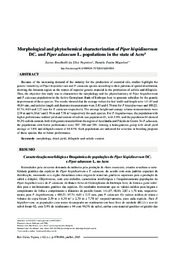Morphological and phytochemical characterization of Piper hispidinervum DC. and Piper aduncum L. populations in the state of Acre.
Morphological and phytochemical characterization of Piper hispidinervum DC. and Piper aduncum L. populations in the state of Acre.
Author(s): NEGREIROS, J. R. da S.; NIQUELONI, D. P.
Summary: Because of the increasing demand of the industry for the production of essential oils, studies highlight the genetic variability of Piper hispidinervum and P. aduncum species according to their patterns of spatial distribution, showing the Amazon region as the source of superior genetic material in the production of safrole and dillapiole. Thus, the objective this study was to characterize the morphology and the phytochemistry of Piper hispidinervum and P. aduncum populations in the Active Germplasm Bank of Embrapa Acre to generate subsidies for the genetic improvement of these species. The results showed that the average values for leaf width and length were 141.67 and 48.04 mm, and petioles length and diameter measurements were 2.83 and 1.78 mm for P. hispidinervum and 189.22; 67.74; 6.03 and 2.22 mm for P. aduncum respectively. The average height and canopy volume measurements were 2.39 m and 6.30 m3 and 2.70 m and 7.78 m3 respectively for each species. For P. hispidinervum, the population with higher performance indried yield and content of safrole was population 02, with 3.9%, and the population 04 showed 94.3% safrole content, both with genetic material from the region of Acrelândia and Plácido de Castro. To P. aduncum, the populations with better performance were 207, 208 and 209, forming a homogeneous group with dried yield average of 3.8% and dillapiol content of 84-85%. Such populations are indicated for selection in breeding program of these species due to better performance.
Publication year: 2015
Types of publication: Journal article
Unit: Embrapa Acre
Keywords: Aceites esenciales, Acre, Amazonia Occidental, Amazônia Ocidental, Banco de Germoplasma, Biogeografia, Biogeography, Dilapidol, Dilapiol, Embrapa Acre, Essential oils, Fitomejoramiento, Genetic variation, Melhoramento genético vegetal, Morfologia vegetal, Morfología de las plantas, Physicochemical properties, Pimenta de macaco, Pimenta longa, Piper aduncum, Piper hispidinervum, Piper longum, Plant breeding, Plant morphology, Propiedades fisicoquímicas, Propriedade físico-química, Rio Branco (AC), Safrol, Safrole, Variación genética, Variação genética, Western Amazon, Óleo essencial
Observation
Some of Embrapa's publications are published as ePub files. To read them, use or download one of the following free software options to your computer or mobile device. Android: Google Play Books; IOS: iBooks; Windows and Linux: Calibre.
Access other publications
Access the Agricultural Research Database (BDPA) to consult Embrapa's full library collection and records.
Visit Embrapa Bookstore to purchase books and other publications sold by Embrapa.

